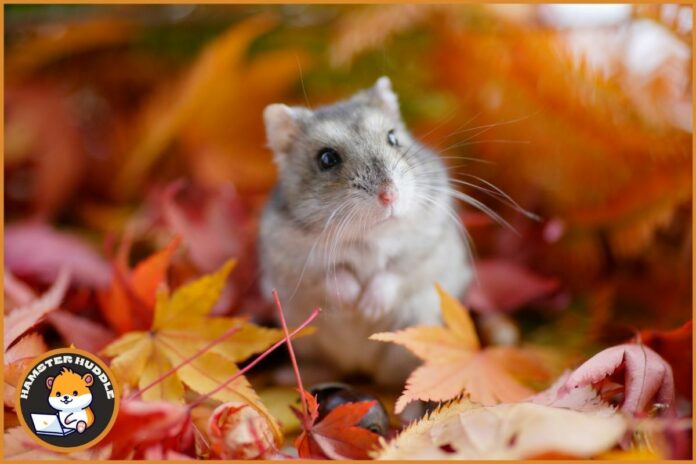Walnuts are a safe treat for hamsters in small amounts, but it’s important to make sure that the shell is removed before feeding them to your pet. The shell can be difficult for hamsters to digest and can cause choking or other health issues.
Hamsters are popular pets, and their owners want to make sure they stay healthy. Knowing which foods are safe for hamsters is important!
One of the most common questions among hamster owners is whether or not walnuts can be part of a hamster’s diet. Fortunately, it turns out that walnuts are safe for hamsters in small amounts.
In this article, we’ll explore why walnuts can be beneficial for your pet, as well as how much you should feed them.
What You'll Learn
Benefits Of Walnuts For Hamsters
Walnuts have a wide range of health benefits that make them an ideal snack for hamsters.
Not only are walnuts packed with protein, but they also contain essential fatty acids and dietary fiber which helps promote gut health in hamsters.
Their high nutritional value makes them an excellent source of energy as well, providing the necessary fuel for your furry friend to stay active during playtime.
In addition to their nutritional content, walnuts provide several other advantages for pet hamsters.
They can help sharpen mental acuity by stimulating the brain and improving memory recall.
The extra calcium present in walnuts can also aid in strengthening bones and teeth while improving overall cardiovascular health.
However, it’s important to remember that moderation is key when giving treats like walnuts to hamsters.
While these snacks offer many beneficial properties, too much of a good thing can lead to digestive issues or excessive weight gain if not monitored properly.
This brings us to our next point: how much should hamsters eat?
How Much Walnuts Should Hamsters Eat
When it comes to feeding walnuts to hamsters, there are a few important considerations. First of all, owners should be aware that some animals may have allergies or intolerances to certain types of nuts and seeds. Secondly, portion control is key in order to avoid digestive problems or other health issues. Lastly, selecting the right type of walnut for your pet is essential for optimal nutrition.
Here are three things you need to consider when offering walnuts to your hamster:
- Avoid any potential allergies by consulting with a vet before introducing them into their diet
- Monitor portions closely as too much can cause digestive distress
- Choose organic, unprocessed versions with no added salt, sugar, oils or preservatives
Given these guidelines, adding small amounts of walnuts into a hamster’s regular diet can provide an additional source of vitamins and minerals while also allowing them to enjoy something new and tasty! To ensure they get all the nutritional benefits without suffering any adverse effects from eating too many nuts at once, it’s best to give them only one nut per day; this way, you can monitor how well they tolerate it and adjust accordingly.
Next up is choosing the right kind of walnuts for your furry friend – read on for more information about which varieties are safest and most nutritious!
Choosing The Right Type Of Walnuts
Amazingly, walnuts are a great snack for hamsters! Not only do they provide them with the delicious taste of nutty goodness, but they also offer several important nutrients. But like any treat given to our furry friends, it’s important to ensure that we feed our hamsters in safe amounts.
To make sure your pet is receiving all the nutrition and energy they need while still avoiding potential health risks associated with feeding too many walnuts, let’s dive into what type of walnuts are best for our little critters.
When selecting which type of walnut is right for your beloved companion, there are some key points to consider. Firstly, you should look at the size of the nut itself – it should be small enough for your hamster to handle easily so as not to cause any choking hazards. Secondly, stick with shelled nuts instead of pre-cracked ones; this will help avoid shells getting stuck inside your hamster’s mouth or throat. Additionally, try choosing organic sources since these provide higher levels of essential vitamins and minerals compared to non-organic varieties. Lastly, always make sure that whatever variety you choose does not contain added sugar or other unhealthy ingredients that could lead to stomach upset if ingested by your furry friend!
It’s worth noting that despite its nutritional benefits, walnuts can be high in fat content when consumed in large quantities – something no creature needs more of! Therefore, even though you may want to spoil your pal every now and again with their favorite treat, limit the amount of walnuts given on a daily basis according to the instructions provided on packaging labels or through consulting an experienced veterinarian.
This way both you and your fluffy friend can relax knowing that their diet includes all the necessary nutrient sources without overdoing it on treats like this one!
Now that we know how much and what kind of walnuts our little furball can safely eat, let’s take a closer look at potential health risks associated with feeding them too often…
Potential Health Risks Of Feeding Walnuts
Choking Hazards:
Walnuts can be a choking hazard for hamsters, so it’s important to break them into smaller pieces before giving them to your pet.
Nutrient Imbalances:
Walnuts are high in fat and protein, so they can cause a nutrient imbalance if they’re given too often.
Digestive Issues:
Walnuts can be difficult for hamsters to digest, so it’s best to give them in moderation. Too much can lead to digestive issues like diarrhea or constipation.
Choking Hazards
When feeding walnuts to hamsters, it’s important to consider potential health risks.
One of these is choking hazards due to their hard shell and small size.
Hamsters should only be given shelled walnuts in very small portions, no larger than the size of their noses.
Feeding techniques are also important; they should never be given whole walnuts as this could cause them to choke or seriously injure their mouths trying to crack open the shells.
Instead, break the nuts into tiny pieces that can easily fit inside a hamster’s mouth without any risk.
These pieces should also not exceed a quarter inch in length or width.
It’s also essential to monitor how much your pet consumes so you don’t accidentally overfeed them with something potentially dangerous like walnuts.
With proper precautions taken, however, hamsters can enjoy eating walnuts safely and responsibly.
Nutrient Imbalances
It’s also important to consider potential nutrient imbalances when feeding walnuts to hamsters.
Since they are high in fat and low in protein, it’s essential to limit the amount of walnuts given so that your pet doesn’t get too much fat relative to their other nutritional needs.
This means selecting a variety of other foods such as vegetables, fruits, nuts, seeds, and commercial hamster food for them to eat instead.
It’s also important to keep portions small; no more than one or two shelled pieces per day is plenty for most adult-sized hamsters.
By ensuring proper selection and portion size of all food items you provide your pet with, you can help prevent any serious health issues caused by an unbalanced diet.
Ultimately, this will go a long way towards maintaining your hamster’s good health and well-being over time.
Digestive Issues
Digestive issues can also arise if walnuts are overfed to hamsters. Because they contain a high fat content, these nuts can be difficult for small animals like hamsters to digest and may cause stomach sensitivity or digestive problems.
It’s best to give your pet only one or two shelled pieces of walnut per day; any more than this could lead to digestive discomfort and possibly even intestinal blockage in some cases.
Additionally, it is important that you select other foods with lower fat content such as fruits, vegetables, seeds, and commercial hamster food so that your pet’s diet remains balanced and healthy overall.
By doing this, you can help ensure that your pet does not suffer from any digestive issues due to an unhealthy diet.
Alternative Treats For Hamsters
Hamsters are omnivores and have specific feeding habits. To make sure they stay healthy, it’s important to provide them with a balanced diet that meets their nutrition needs.
While walnuts can be an occasional treat for hamsters, there are other options available:
- Dried fruits such as apples, apricots, and bananas
- Vegetables like broccoli, cauliflower, and carrots
- High-quality store-bought treats specifically designed for small animals
When giving your hamster any of these alternative treats, it is essential to remember not to overfeed them. Offer only a few bites at a time so that the food does not exceed more than 10% of their daily caloric intake.
Additionally, it’s best to avoid sugary or salty snacks altogether since these items could negatively impact the health of your pet.
Moving forward from here we will look into how you can safely store and prepare walnuts for your furry friend.
Storing And Preparing Walnuts For Hamsters
Alternative treats for hamsters, such as walnuts, can provide a healthy and entertaining snack. However, to ensure the safety of your furry friend it is important to store and prepare walnuts correctly.
Soaking nuts before giving them to the hamster will help soften them so that they are easier for the small animal to digest. Additionally, portion control should be applied when feeding your pet a treat like this; too much could cause stomach problems or even make him sick.
When deciding how many walnuts to give your hamster, keep in mind their size relative to his own body. It’s best not to exceed one nut per day since these snacks do contain high levels of fat which can lead to obesity if consumed in excess. Furthermore, it’s wise to inspect each nut carefully before feeding it – tiny pieces of shell could easily get stuck in the back of its throat and choke it!
In order to soak the nuts properly, you’ll need some warm water and a container where they can fit comfortably without overcrowding. Leave them submerged overnight then rinse off any dirt residue with cold water before offering them up as an edible reward.
Walnuts must also be stored away from direct light sources and kept at room temperature in order prevent spoilage or mold growth over time.
Providing alternative treats like walnuts helps keep your little buddy entertained while adding variety into its diet plan. If done safely and responsibly, these tasty morsels can become part of a balanced meal regimen that will bring joy (and full bellies!) for years down the line!
Conclusion
In conclusion, walnuts are a great treat for hamsters and can benefit their overall health when given in the right amounts.
However, it’s important to remember that too much of anything isn’t healthy; this is especially true with walnuts as they contain high levels of fat.
Therefore, I would strongly recommend limiting the amount you give your furry friend and opt for alternative treats like fresh fruits instead.
That said, if there’s any food that will make your hamster happier than a tasty walnut, it’ll be something yet to be discovered!



